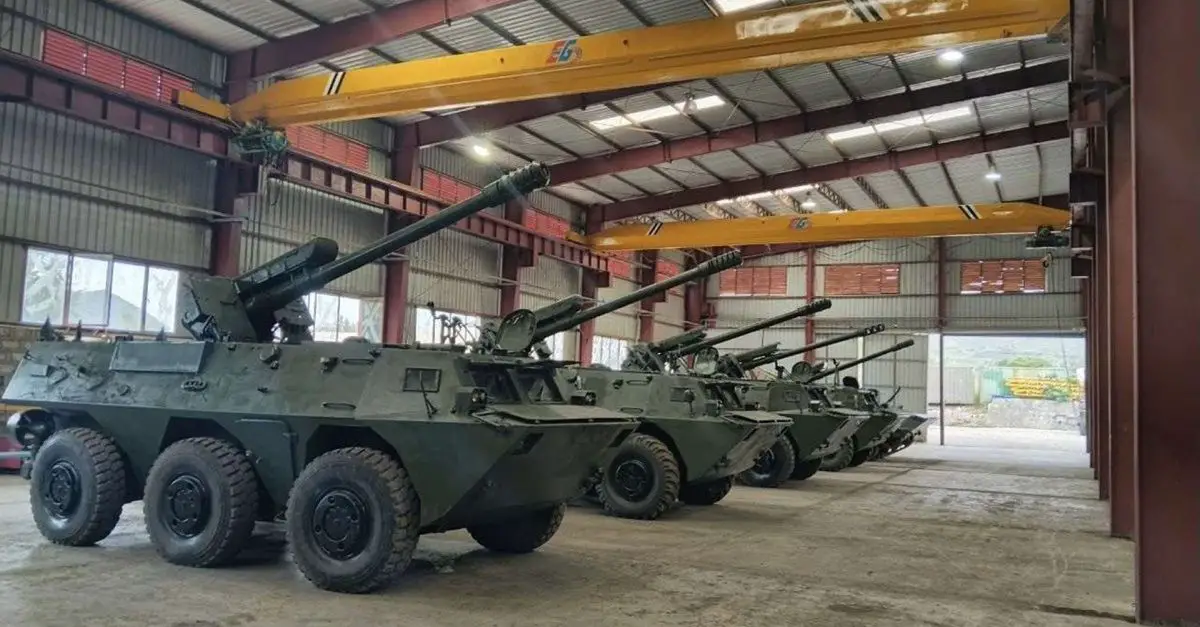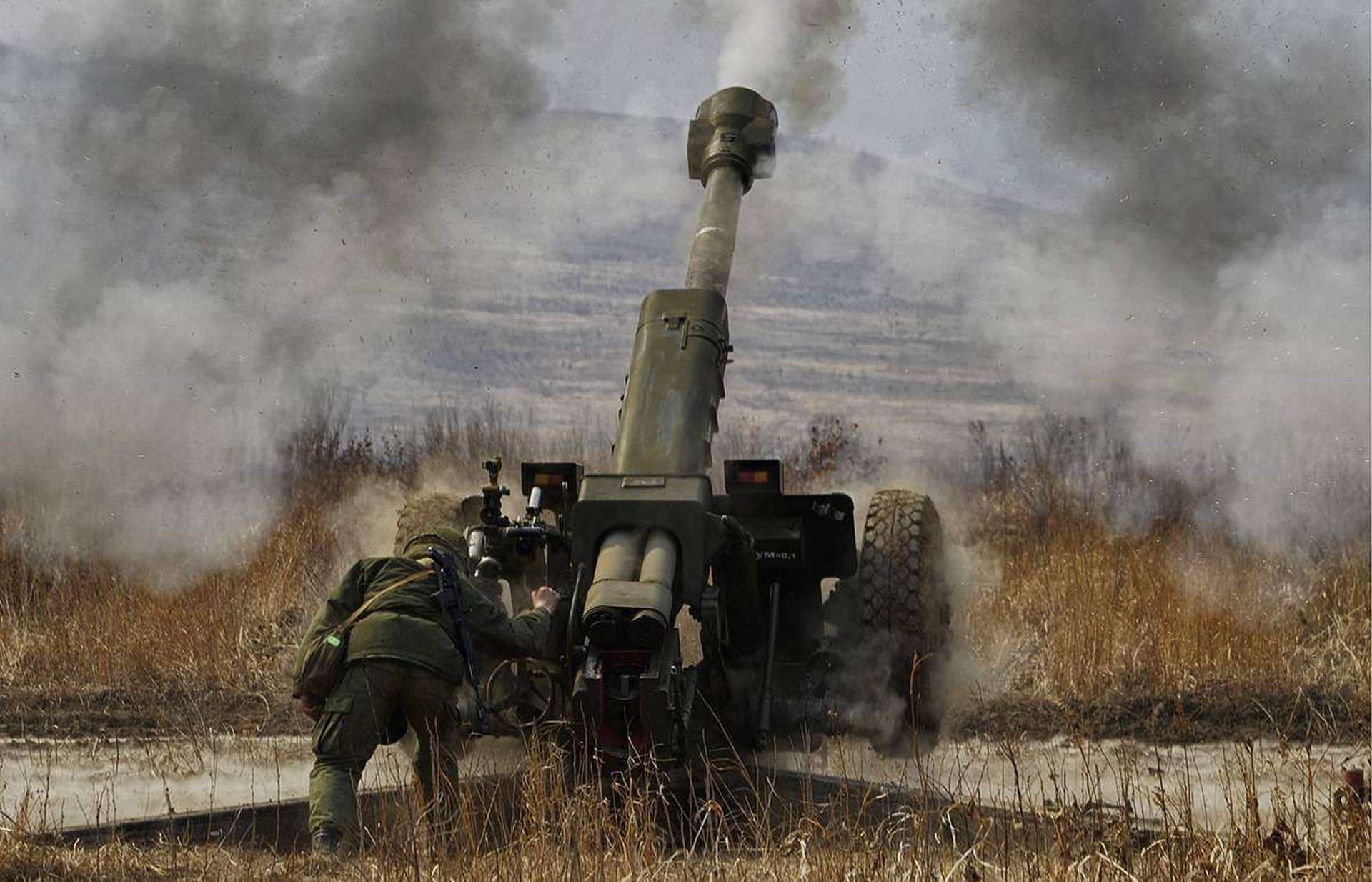Breaking News
Ethiopia converts Chinese WZ551 APCs into self-propelled howitzers with Soviet-era artillery.
On August 7, 2024, the Ethiopian National Defense Force (ENDF), also referred to as the FDRE Defense Force, converted several Chinese-made WZ551 6x6 armored personnel carriers (APCs), originally designed for troop transport, into self-propelled howitzers by integrating Soviet-era D-30 122mm towed howitzers. This announcement follows ongoing efforts by the Ethiopian military to improve its combat readiness, a focus that has been prominent since August 1, 2016, under the leadership of the head of defense logistics.
Follow Army Recognition on Google News at this link

Ethiopia recently converted several Chinese-made WZ551 6x6 armored personnel carriers (APCs), originally designed for troop transport, into self-propelled howitzers by integrating Soviet-era D-30 122mm towed howitzers. (Picture source: ENDF)
These D-30 howitzers, typically used as towed artillery pieces, have been installed in a manner that allows for operation from within the troop compartment of the WZ551 APC. A new armor shield has been added to provide limited frontal protection for the operators. A photograph released on August 7 depicted at least four such modified vehicles, believed to be located at the Defence Engineering Industry Corporation near Bishoftu, a key facility in Ethiopia's defense sector.
This effort to repurpose the WZ551 into a mobile artillery platform is consistent with previous Ethiopian military practices, where available resources have been adapted to meet specific needs. Historically, the Ethiopian armed forces have employed similar methods, such as mounting D-30 howitzers on T-55 tank chassis to create Soviet-style self-propelled guns. The current modification of the WZ551 appears to be a continuation of these earlier efforts, albeit executed in a more organized fashion.
The decision to modify these vehicles comes despite Ethiopia's recent acquisition of modern artillery systems, such as the Russian 2S19 Msta-S. As reported in November 2023, Ethiopia also recently received 32 SH-15 155mm self-propelled howitzers from China North Industries Corporation (Norinco), a more advanced system compatible with precision-guided munitions such as the GP155 or GP1. This raises questions about the continued use of older Soviet-era howitzers, given the availability of more modern options. It may suggest a strategy focused on maximizing the use of existing military assets while exploring cost-effective ways to enhance artillery mobility.

The WZ551 has been exported to various countries, including Algeria, Ivory Coast, Sudan, Nepal, and Pakistan, where it serves in different capacities depending on the variant. (Picture source: Chinese social media)
The WZ551 Armored Personnel Carrier (APC) was developed by China during the 1980s as part of an effort to enhance its military capabilities with a flexible wheeled vehicle platform. The initial prototype, known as the Type 90 (WZ551), was based on the chassis of the Tiema XC2030 6x6 truck and was first revealed in 1984. However, due to performance shortcomings, particularly in engine reliability, it was not widely adopted. Subsequent development led to the Type 92 (WZ551A), which incorporated significant improvements, including a more reliable air-cooled engine and enhanced cross-country performance. This variant entered service with the Chinese People's Liberation Army Ground Force (PLAGF) in the 1990s.
The WZ551 family includes several variants designed for different roles. The standard 6x6 APC version is equipped with a 12.7 mm machine gun, while the infantry fighting vehicle (IFV) variant carries a 25 mm autocannon. Additional versions include the Yitian air defense system, anti-tank guided missile carriers, and specialized vehicles like self-propelled artillery, command vehicles, and ambulances. The WZ551 has been exported to various countries, including Algeria, Sudan, Nepal, and Pakistan, where it serves in different capacities depending on the variant.
In terms of technical specifications, the WZ551 has a combat weight of approximately 15.3 tons and is powered by a Deutz BF8L 413FC diesel engine, which produces 320 horsepower. This enables the vehicle to reach a top speed of 85 km/h on paved roads. The vehicle features an all-welded steel hull that provides protection against small arms fire and shrapnel. It is equipped with a nuclear, biological, and chemical (NBC) protection system, as well as an automatic fire suppression system. The WZ551 can accommodate a crew of two or three, depending on the variant, along with up to nine infantry personnel in the troop compartment.

The D-30 has seen extensive use in various conflicts, including the Iran-Iraq War, the Afghan-Soviet War, and the Syrian Civil War, due to its operational reliability and suitability for diverse combat environments. (Picture source: Russian social media)
The D-30 howitzer, a Soviet-designed 122mm artillery piece, was developed in the late 1950s to replace the older M-30 howitzer, which had been in service since World War II. It was introduced into service in the early 1960s and featured an innovative three-leg mounting system that allowed a 360-degree traverse. This design aimed to provide greater stability and flexibility compared to its predecessors. The D-30 was widely exported and used by Warsaw Pact nations and other Soviet allies, becoming a common artillery system in numerous military forces worldwide.
The D-30 has seen extensive use in various conflicts, including the Iran-Iraq War, the Afghan-Soviet War, and the Syrian Civil War. Its widespread use is due to its operational reliability and suitability for diverse combat environments. Several countries have adopted the D-30, with some developing local variants. For example, Algeria has created a self-propelled version mounted on a Mercedes-Benz truck, and China has produced its own versions, such as the Type 86 and Type 96. The D-30 continues to be used by many nations, particularly in developing regions, indicating its continued relevance in modern military operations.
The D-30 was created as a 122mm towed howitzer, weighing approximately 3.2 tons, with a barrel length of 4.875 meters. It has a maximum range of 15.4 kilometers with standard high-explosive fragmentation (HE-Frag) shells, extendable to 21.9 kilometers using rocket-assisted projectiles. The howitzer can sustain a rate of fire of 7-8 rounds per minute. Its three-leg carriage design allows for rapid deployment and stabilization, crucial for maintaining accuracy in long-range firing. Additionally, the D-30 includes a multi-slotted muzzle brake that helps manage recoil.


























